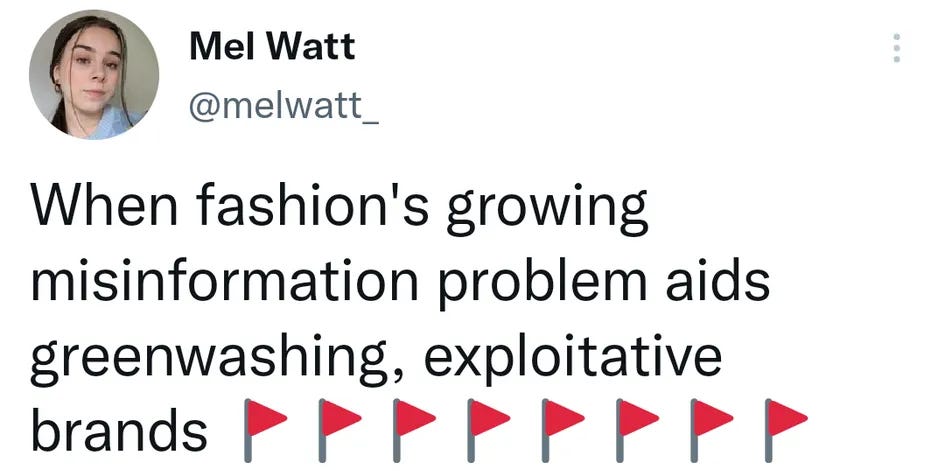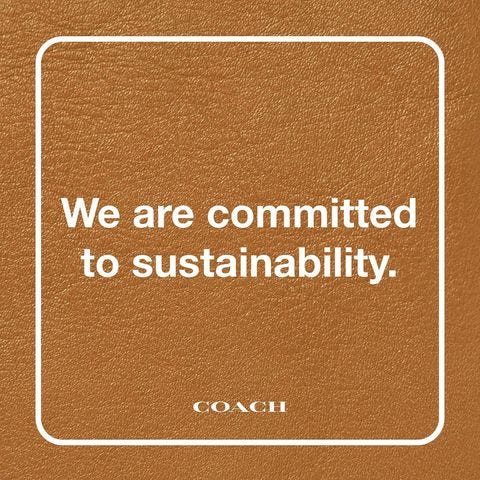FYI, Caught Green Handed is a newsletter interrogating the relationship between fashion and green capitalism. If you enjoy this post, subscribe to get more hot, anti-greenwashed takes directly in your inbox 🫶
I’ll put my hands up: I’ve called cotton a thirsty crop approximately 200+ times. It’s a phrase I picked up from reputable sources, The Ellen MacArthur Foundation and Fashion Revolution among them.
So, what’s the issue? ‘Thirsty cotton’ is largely a misnomer and one small part of fashion’s growing misinformation problem which sees inaccurate, outdated figures repeated without context until they reach the status of gospel truth. When you try to locate the origin of these “facts”, you’ll soon find yourself on a wild goose chase. Cited studies have either vanished, aged to the point of irrelevance or suffer from major methodological flaws. As long as glaring data gaps exist, however, these studies will continued to be revered by even the most well-meaning of organisations, experts and activists.
A newly published report, Cotton: A Case Study in Misinformation, sheds light on this problem by zooming in on the planet’s second most-produced fibre: cotton. Published by the Transformers Foundation, research was co-lead by intellelligence director and cofounder of Cotton Diaries, Marzia Lanfranchi, and sustainable fashion journalist and author, Elizabeth L. Cline. The timely report was born out of a duel need to train consumers and stakeholders to critically analyse data and to publicly share the best available information on cotton, with hopes of collating an open data bank for other fibres in the future.
The report debunks 4 key myths surrounding the natural fibre. It does so not to clear cotton’s name (as one article suggested) but to underline the scary extent that misleading info has entered the mainstream. It begins by highlighting that cotton isn’t necessarily a water-thirsty crop. This blanket statement fails to acknowledge that cotton is grown in many water-stressed regions.
You’ve probably stumbled across an infographic which reads “20,000 litres of water are needed to make one t-shirt and a pair of jeans”. Well, it turns out that figure is likely a lot closer to 1,931 litres of irrigation water and 6,003 litres of rainwater. The oft-cited claim that non-organic cotton cultivation uses up 25% of the world’s pesticides is similarly disproven.
The fourth refuted figure is that organic cotton uses 91% less water than conventional cotton - a stat thrown around by the likes of H&M and Inditex to legitimise their “sustainable” ranges. The figure was blindly taken from a 7-year-old study by the Textile Exchange. The study is discredited because it has “not been critically reviewed” and should therefore “be avoided”.
The report concludes with 4 calls to action, calling for more in-depth research to fill data gaps, offering to review new studies, and advocating for all data - data that is often buried behind paywalls or plagued with scientific jargon - to be made open-source and publicly accessible. The fourth call to action is my personal fave: to establish a global fashion fact-checker. When journalism 101 rules apparently fail to apply to vast swathes of fashion media, a fact-checker ensures that up-to-date, accurate information returns as a cornerstone of fashion reporting. It also provides authenticated ammo to call out fibbing brands on Twitter, a favourite pastime of mine.
To be sure, misinformation isn’t limited to cotton production. We don’t know a whole lot about the true environmental and social impacts of many fibres, processes and systems within the fashion industry. Fashion’s fake news problem only serves the greenwashers and maintains the status quo of a notoriously opaque industry, reducing the number of opportunities to tackle the issue head on.
See, if you can’t diagnose the exact nature of a problem, it becomes a lot harder to devise effective solutions. Quoting from the report, we need accurate information “so that best practices can be developed and implemented, industries can make informed choices, and farmers and other suppliers and makers can be rewarded for and incentivised to operate using more responsible practices that drive more positive impacts”.
It can take months to form a new habit and probably just as long to drop the facts and figures that we’re so used to rolling off the tongue. But if we want to transform the fashion industry, we need to be open to relearning everything we thought we knew about sustainability. Complex issues require educated solutions.
Caught Green Handed: Coach
“If your bag is broken or worn, don’t chuck it, repair it!” reads the opening line of Coach’s repair guarantee, a one-year warranty on its leather goods for all quality defects. Earlier this year, the luxury handbag brand launched upcycling service ReLoved which reimagines customers’ unwanted, gently used bags in exchange for store credit. Both services underpin Coach’s sustainability pledge to “keep bags out of landfills and to reduce our impact on the environment”.
While not exactly a fully-fledged mission to regenerate post-consumer goods, Coach’s circular-marketed services are a stepping stone to extend the use of its products. Or so it seems. Behind closed doors, retail staff are instructed to slash returned, supposedly unsellable goods, as a viral TikTok by Anna Sacks (otherwise known as The Trash Walker) exposed. In the 1-minute video, Sacks shows countless purses that have been hacked apart, but otherwise show no signs of justifiable damage. The slashed bags were retrieved from a dumpster outside a Coach store.
Destroying unwanted merchandise is nothing new. In 2018, Burberry came under fire for incinerating £28.6 million worth of unsold stock. Designer labels have also been known to damage unsold luxury goods to maintain the exclusivity of their brand. For Coach, its in-store disposal policy provided a tax loophole where it could write off all purposefully destroyed bags in the same way companies write off accidentally damaged stock. In a statement given to Fashionista, Coach clarified that “the damaged product that was being destroyed in stores represents less than 1% of global sales”. Elizabeth Cline estimates that this amounts to a staggering $200m worth of bags. In other words, a fuck ton of landfill waste that Coach cheekily urges customers to combat by paying for its upcycling service.
Facing public backlash, Coach u-turned on its policy and “have now ceased destroying in-store returns of damaged, defective, worn and otherwise unsalable goods”. In a damage control Instagram post, Coach reaffirmed its commitment to recycling damaged bags through its ReLoved service and developing new ways to responsibly repurpose excess or damaged products. Of course, Coach would have continued to operate business as usual had it not been caught out.
And what is a performative apology without a guilt-tripping redemption arc? Coach continues that it has “donated product valued at over $55 million to support low-income families, individuals in need, those re-entering the workforce and education programmes”. How ever commendable, it begs the question: why is Coach overproducing so much in the first place?! Circular goals are surely destined to fail if they don’t prioritise degrowth.
So, what lessons can be taken away from this?
1) This is textbook greenwashing in action. Deploying the sin of the hidden trade off, Coach emphasised the environmental benefits of its repair and upcyling services, while over-producing an unholy amount of landfill-destined product. You can’t position yourself as the solution to the waste crisis if you directly create that mess in the first place. And then hide this fact from the public.
2) Luxury price tags don’t come with inbuilt ethics. Designer labels seem to escape the wagging finger aimed at fast fashion brands but often produce their products in the same supplier factories and fail to pay their makers a living wage and contribute to the same environmental footprint.
3) Sustainability isn’t a marketing strategy. It’s not a pick-and-choose exercise or some commercial bonus. It’s a moral duty.
Did you enjoy this post? Please share it with a friend, subscribe or gift me a virtual cuppa. I’ll never put my content behind a paywall so Ko-fi is a small and optional way to support my work 🫶






